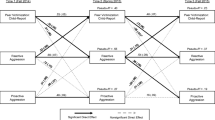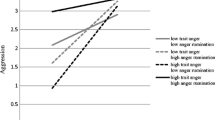Abstract
The current short-term longitudinal study evaluated whether anger and sadness regulation moderated the associations between peer victimization and physical and relational forms of aggression over a 6-month period. Participants included 278 predominantly Caucasian children (51.8 % female) between 8 and 12 years of age (M = 9.33, SD = 0.99). Peer victimization was assessed at Time 1 using child- and teacher-reports, and teachers provided ratings of children’s aggressive behavior at Time 1 and Time 2. Children also completed self-report measures of anger and sadness regulation at Time 1. Results from multilevel models provided support for the notion that children’s ability to effectively regulate their feelings of anger and sadness influences the relations among peer victimization and forms of aggression over time. As anticipated, high levels of anger regulation attenuated the link between child-reported peer victimization and physical aggression. Further, when levels of anger regulation were high, teacher-reported peer victimization predicted subsequent decreases in physical aggression. Contrary to expectations, however, high levels of anger and sadness regulation exacerbated the association between child-reported peer victimization and relational aggression, and teacher-reported peer victimization predicted decreases in relational aggression over time when levels of anger regulation were low. Directions for future research and implications for practice are discussed.



Similar content being viewed by others
Notes
However, a post-hoc analysis of the marginally statistically significant interaction (p = 0.07) revealed that whereas teacher-reported peer victimization was unrelated to relational aggression at moderate (β = −0.11, SE = 0.07, p = 0.12) to high (β = −0.03, SE = 0.08, p = 0.75) levels of sadness regulation, it predicted subsequent decreases in relational aggression when levels of sadness regulation were low (β = −0.20, SE = 0.09, p = 0.03). Thus, this nonsignificant trend also appears to replicate the results from the models using child-reports of peer victimization.
References
Aiken, L., & West, S. G. (1991). Multiple regression: Testing and interpreting interactions. Newbury Park: Sage.
Bandura, A. (1973). Aggression: A social learning analysis. Englewood Cliffs: Prentice-Hall.
Bouman, T., van der Meulen, M., Goossens, F. A., Olthof, T., Vermande, M. M., & Aleva, E. A. (2012). Peer and self-reports of victimization and bullying: their differential association with internalizing problems and social adjustment. Journal of School Psychology, 50, 759–774. doi:10.1016/j.jsp.2012.08.004.
Bradshaw, C. P., Sawyer, A. L., & O’Brennan, L. M. (2007). Bullying and peer victimization at school: perceptual differences between students and school staff. School Psychology Review, 36, 361–382. Retrieved from http://www.nasponline.org/publications/spr/index-list.aspx.
Camodeca, M., & Goossens, F. A. (2005). Aggression, social cognitions, anger and sadness in bullies and victims. Journal of Child Psychology and Psychiatry, 46, 186–197. doi:10.1111/j.1469-7610.2004.00347.x.
Campos, J. J., Campos, R. G., & Barrett, K. C. (1989). Emergent themes in the study of emotional development and regulation. Developmental Psychology, 25, 394–402. doi:10.1037/0012-1649.25.3.394.
Card, N. A., Stucky, B. D., Sawalani, G. M., & Little, T. D. (2008). Direct and indirect aggression during childhood and adolescence: a meta-analytic review of gender differences, intercorrelations, and relations to maladjustment. Child Development, 79, 1185–1229. doi:10.1111/j.1467-8624.2008.01184.x.
Cole, P. M., & Hall, S. E. (2008). Emotion dysregulation as a risk factor for psychopathology. In T. P. Beauchaine & S. P. Hinshaw (Eds.), Child and adolescent psychopathology (pp. 265–298). Hoboken: Wiley.
Cole, P. M., Michel, M., & O’Donnell Teti, L. (1994) The development of emotion regulation and dysregulation: A clinical perspective. In N. Fox (Ed.), The development of emotion regulation: Behavioral and biological considerations. Monographs of the Society for Research in Child Development, 59, 73–100. doi:10.2307/1166139.
Crick, N. R., & Bigbee, M. A. (1998). Relational and overt forms of peer victimization: a multi-informant approach. Journal of Clinical and Consulting Psychology, 66, 337–347. doi:10.1037/0022-006X.66.2.337.
Crick, N. R., & Grotpeter, J. K. (1996). Children’s treatment by peers: victims of relational and overt aggression. Development and Psychopathology, 8, 367–380. doi:10.1017/S095479400007148.
Crick, N. R., Casas, J. F., & Ku, H. C. (1999). Relational and physical forms of peer victimization in preschool. Developmental Psychology, 33, 579–588. doi:10.1037/0012-1649.35.2.376.
Dill, E. J., Vernberg, E. M., Fonagy, P., Twemlow, S. W., & Gamm, B. K. (2004). Negative affect in victimized children: the roles of social withdrawal, peer rejection, and attitudes towards bullying. Journal of Abnormal Child Psychology, 32, 159–173. doi:10.1023/B:JACP.0000019768.31348.81.
Dodge, K. A., & Coie, J. D. (1987). Social-information processing factors in reactive and proactive aggression in children’s peer groups. Journal of Personality and Social Psychology, 53, 1146–1158. doi:10.1037/0022-3514.53.6.1146.
Dodge, K. A., Coie, J. D., & Lynam, D. (2006). Aggression and antisocial behavior in youth. In W. Damon (Series Ed.) & N. Eisenberg (Vol. Ed.), Handbook of child psychology: Vol. 3. Social, emotional, and personality development (6th ed., pp. 719–788). Hoboken, NJ: John Wiley.
Felix, E. D., & McMahon, S. D. (2007). The role of gender in peer victimization among youth: a study of incidence, interrelations, and social cognitive correlates. Journal of School Violence, 6, 27–44. doi:10.1300/J202v06n03_03.
Fite, P. J., Williford, A., Cooley, J. L., DePaolis, K., Rubens, S. L., & Vernberg, E. M. (2013). Patterns of victimization locations in elementary school children: effects of grade level and gender. Child and Youth Care Forum, 42, 585–597. doi:10.1007/s10566-013-9219-9.
Fite, P. J., Evans, S. C., Cooley, J. L., & Rubens, S. L. (2014). Further evaluation of the associations between attention-deficit/hyperactivity and oppositional defiant disorder symptoms and bullying-victimization in adolescence. Child Psychiatry and Human Development, 45, 32–41. doi:10.1007/s10578-013-0376-8.
Graham, S., & Juvonen, J. (1998). Self-blame and peer victimization in middle school: an attributional analysis. Developmental Psychology, 34, 587–599. doi:10.1037/0012-1649.34.3.587.
Herts, K. L., McLaughlin, K. A., & Hatzenbuehler, M. L. (2012). Emotion dysregulation as a mechanism linking stress exposure to adolescent aggressive behavior. Journal of Abnormal Child Psychology, 40, 1111–1122. doi:10.1007/s10802-012-9629-4.
Izard, C. E., & Ackerman, B. P. (2000). Motivational, organization, and regulatory functions of discrete emotions. In M. Lewis & J. M. Haviland-Jones (Eds.), Handbook of emotions (2nd ed., pp. 253–264). New York: Guilford Press.
Kawabata, Y., Tseng, W., & Crick, N. R. (2014). Adaptive, maladaptive, meditational, and bidirectional processes of relational and physical aggression, relational and physical victimization, and peer liking. Aggressive Behavior, 40, 273–287. doi:10.1002/ab.21517.
Kaynak, O., Lepore, S. J., Kliewer, W., & Jaggi, L. (2015). Peer victimization and subsequent disruptive behavior in school: the protective functions of anger regulation coping. Personality and Individual Differences, 73, 1–6. doi:10.1016/j.paid.2014.09.012.
Kochenderfer-Ladd, B. (2004). Peer victimization: the role of emotions in adaptive and malaptive coping. Social Development, 13, 329–349. doi:10.1111/j.1467-9507.2004.00271.x.
Kochenderfer-Ladd, B., & Ladd, G. W. (2010). A child-by-environment framework for planning interventions with children involved in bullying. In E. M. Vernberg & B. K. Biggs (Eds.), Preventing and treating bullying and victimization (pp. 45–74). New York: Oxford University Press, Inc.
Kochenderfer-Ladd, B., & Wardrop, J. L. (2001). Chronicity and instability of children’s peer victimization experiences as predictors of loneliness and social satisfaction trajectories. Child Development, 72, 134–151. doi:10.1111/1467-8624.00270.
Mahady Wilton, M. M., Craig, W. M., & Pepler, D. J. (2000). Emotional regulations and display in classroom victims of bullying: characteristic expressions of affect, coping styles and relevant contextual factors. Social Development, 9, 226–244. doi:10.1111/1467-9507.00121.
Murray-Close, D., Ostrov, J. M., & Crick, N. R. (2007). A short-term longitudinal study of growth of relational aggression during middle childhood: associations with gender, friendship intimacy, and internalizing problems. Development and Psychopathology, 19, 187–203. doi:10.1017/S0954579407070101.
Neal, D. J., & Simons, J. S. (2007). Inference in regression models of heavily skewed alcohol use data: a comparison of ordinary least squares, generalized linear models, and bootstrap resampling. Psychology of Addictive Behaviors, 21, 441–452. doi:10.1037/0893-164X.21.4.441.
Nishina, A., & Juvonen, J. (2005). Daily reports of witnessing and experiencing peer harassmen in middle school. Child Development, 76, 435–450. doi:10.1111/j.1467-8624.2005.00855.x.
Nylund, K., Bellmore, A., Nishina, A., & Graham, S. (2007). Subtypes, severity, and structural stability of peer victimization: what does latent class analysis say? Child Development, 78, 1706–1722. doi:10.1111/j.1467-8624.2007.01097.x.
Orobio de Castro, B., Bosch, J. D., Veerman, J. W., & Koops, W. (2003). The effects of emotion regulation, attribution, and delay prompts on aggressive boys’ social problem solving. Cognitive Therapy and Research, 27, 153–166. doi: 10.1023/A:1023557125265, doi: 10.1207/s15374424jccp3401_10.
Ostrov, J. M. (2010). Prospective associations between peer victimization and aggression. Child Development, 81, 1670–1677. doi:10.1111/j.1467-8624.2010.01501.x.
Ostrov, J. M., & Godleski, S. A. (2013). Relational aggression, victimization, and adjustment during middle childhood. Development and Psychopathology, 25, 801–815. doi:10.1017/S0954579413000187.
Peled, M., & Moretti, M. M. (2007). Rumination on anger and sadness in adolescence: fueling of fury and deepening of despair. Journal of Clinical Child and Adolescent Psychology, 36, 66–75. doi:10.1207/s15374424jccp3601_7.
Pellegrini, A. D. (1998). Bullies and victims in school: a review and call for research. Journal of Applied Developmental Psychology, 19, 165–176. doi:10.1016/S0193-3973(99)80034-3.
Reijntjes, A., Kamphuis, J. H., Prinzie, P., & Telch, M. J. (2010). Peer victimization and internalizing problems in children: a meta-analysis of longitudinal studies. Child Abuse & Neglect, 34(4), 244–252. doi:10.1016/j.chiabu.2009.07.009.
Reijntjes, A., Kamphuis, J. H., Prinzie, P., Boelen, P. A., van der Schoot, M., & Telch, M. J. (2011). Prospective linkages between peer victimization and externalizing problems in children: a meta-analysis. Aggressive Behavior, 37, 215–222. doi:10.1002/ab.20374.
Roberton, T., Daffern, M., & Bucks, R. (2012). Emotion regulation and aggression. Aggression and Violent Behavior, 17, 72–82. doi:10.1016/j.avb.2011.09.006.
Rose, A. J., Swenson, L. P., & Waller, E. M. (2004). Overt and relational aggression and perceived popularity: developmental differences in concurrent and prospective relations. Developmental Psychology, 40, 378–387. doi:10.1037/0012-1649.40.3.378.
Rudolph, K. D., Troop-Gordon, W., Hessel, E. T., & Schmidt, J. D. (2011). A latent growth curve analysis of early and increasing peer victimization as predictors of mental health across elementary school. Journal of Clinical Child & Adolescent Psychology, 40, 111–122. doi:10.1080/15374416.2011.533413.
Saarni, C. (1999). The development of emotional competence. New York: Guilford.
Sullivan, T. N., Farrell, A. D., & Kliewer, W. (2006). Peer victimization in early adolescence: association between physical and relational victimization and drug use, aggression, and delinquent behaviors among urban middle school students. Development and Psychopathology, 18, 119–137. doi:10.1017/S095457940606007X.
Sullivan, T. N., Helms, S. W., Kliewer, W., & Goodman, K. L. (2010). Associations between sadness and anger regulation copping, emotional expression, and physical and relational aggression among urban adolescents. Social Development, 19, 30–51. doi:10.1111/j.1467-9507.2008.00531.x.
Thompson, R. A. (1994). Emotion regulation: a theme in search of definition. Monographs for the Society for Research in Child Development, 59, 25–52. doi:10.2307/1166137.
Underwood, M. K. (2003). The comity of modest manipulation, the importance of distinguishing among bad behaviors. Merrill-Palmer Quarterly, 49, 373–389. doi:10.1353/mpq.2003.0016.
U. S. Census Bureau (2010). State and County QuickFacts. Retrieved from http://quickfacts.census.gov
Vernberg, E. M., Jacobs, A. K., & Hershberger, S. L. (1999). Peer victimization and attitudes about violence during early adolescence. Journal of Clinical Child Psychology, 28, 386–395. doi:10.1207/S15374424jccp280311.
Werner, N. E., & Crick, N. R. (2004). Maladaptive peer relationships and the development of relational and physical aggression during middle childhood. Social Development, 13, 495–514. doi:10.1111/j.1467-9507.2004.00280.x.
Zeman, J., Shipman, K., & Penza-Clyve, S. (2001). Development and initial validation of the children’s sadness management scale. Journal of Nonverbal Behavior, 25, 187–205. doi:10.1023/A:1010623226626.
Acknowledgments
The authors would like to thank the members of the KU Child Behavior Lab for their invaluable assistance throughout the data collection process. We are especially grateful for the students, teachers, and school administrators who made this research possible.
Conflict of Interest
The authors declare that they have no potential conflicts of interest.
Author information
Authors and Affiliations
Corresponding author
Rights and permissions
About this article
Cite this article
Cooley, J.L., Fite, P.J. Peer Victimization and Forms of Aggression During Middle Childhood: The Role of Emotion Regulation. J Abnorm Child Psychol 44, 535–546 (2016). https://doi.org/10.1007/s10802-015-0051-6
Published:
Issue Date:
DOI: https://doi.org/10.1007/s10802-015-0051-6




